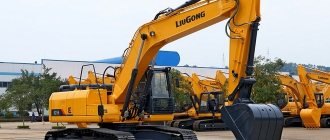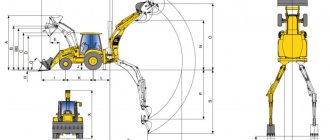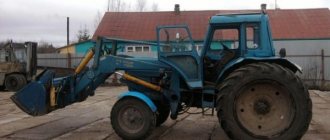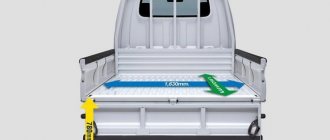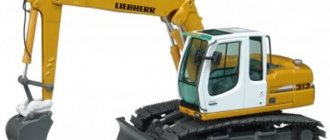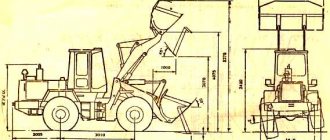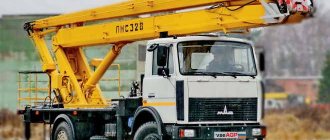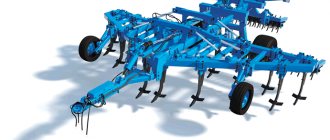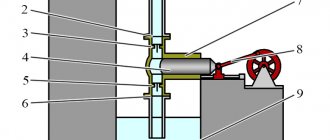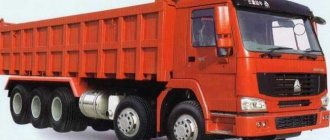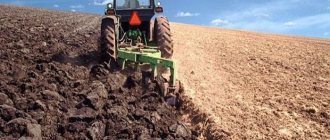A trench excavator is a highly specialized longitudinal digging excavation equipment. It is used in almost all industries, in the field of defense and land reclamation. According to the design, the working element on the base vehicle can be installed permanently or in a removable version. Modular equipment is produced in small quantities. As a rule, a rotary trench excavator is in service with engineering units of law enforcement agencies (PZM, BAT-M). Removable units are more popular because they have wide capabilities. Modern tractors are almost always equipped with a power take-off shaft and a universal bracket, which allows them to be used in conjunction with a mounted excavator. However, the power of tow hitches is limited. Greater operating efficiency is achieved when using modular ETRs.
Scope of application of trench excavators
The working tools of these machines are chains on rollers or buckets rigidly mounted on a rotating wheel. The main purpose of earthmoving equipment is to dig a trench of a certain depth and width. The scope of use of trench excavators is quite wide.
They are involved in excavation work at the following sites:
- Main pipelines. The soil is excavated to a considerable depth to protect the pipes from transport pressure. The width of the trenches can be up to 120 cm. If the trench bucket for an excavator is not wide enough, then excavation is carried out as many times as necessary to achieve the specified parameters.
- Construction of residential buildings and engineering structures. A chain trench excavator is capable of digging a deep foundation pit. Using a working body whose width is 40-60 cm, an earthmoving machine makes a smooth and neat ditch for a strip foundation.
- Mining quarry development. As a rule, units with a rotary working body are used for this. The shape of the excavator bucket is designed to capture a large volume of bulk material and deliver it to the conveyor.
- Laying power and communication cables. For such purposes, equipment is used whose width is 14 cm. To achieve the required level of accuracy, the machine is equipped with electronic monitoring and control devices.
- Protective structures. Trench digging is carried out according to predetermined parameters. The result of excavation work is the creation of trenches, open cracks, communication passages and recesses for dugouts. Protective structures for units of law enforcement agencies are being dug at training grounds and in combat areas to shelter personnel.
- Drainage system. The technical component of this production process involves digging a ditch at a certain angle. In order to achieve the desired result, special equipment is installed in the excavator operator’s cabin to allow the work to be completed in accordance with the specified parameters.
- Irrigation. When mining deposits of precious stones and metals is carried out, there is a need to supply water in large quantities. In cases where the use of trenchless pipe laying technology is not possible, ditches are dug in the open.
During the construction and maintenance of communication routes, machines are used to construct slopes and ditches.
Manufacturers
The production of trench excavators is carried out by companies producing special equipment of both domestic and foreign origin, with representative offices in different countries of the world.
Caterpillar
Caterpillar (USA) is a world leader in the manufacture of all kinds of special equipment of various weight classes. Its product lines include surface and underground vehicles used in mining, agricultural, construction, quarrying and other similar applications. Caterpillar trenchers are designed for construction work for residential, agricultural or commercial purposes. They are excellent at digging shallow trenches for laying pipelines and cables.
Vermeer Manufacturing Company
Vermeer Manufacturing Company (USA) presents several model lines of excavators (several dozen models), including modifications on wheels and tracks, with equipment of both chain and rotary type. The equipment of this company is equipped with electronic control through a microprocessor system, which synchronizes the actions of the tractor and the working parts of the machine. Thanks to this, the control and diagnostics of the machine have been simplified. In addition, some models are equipped with laser systems to control trench depth.
Case Corporation
Case Corporation (France) model lines for trench excavators are significantly narrower than those of Vermeer. These are wheeled vehicles with planetary axles weighing from 327 to 5761 kg, having as main or additional equipment chain and disk type diggers, as well as a drilling rig, etc.
Raditsky Machine-Building Plant LLC
Raditsky plant (Russia, Bryansk) produces rotary excavators based on T-170 crawler tractors. This is colossal equipment weighing up to 32 tons, giving a particularly large trench width and having large conveyors for evacuating the soil dump. Perfectly suited for working with complex rocks containing fine abrasive particles. They are widely used in gas and oil pipeline works.
DSUE "Dmitrov Excavator Plant"
The Dmitrovsky plant presents chain equipment with several types of chains, winter and summer versions, differing in length, width and tooth size. The main base tractor here is MTZ-82. There are models that provide a trench up to 110 cm wide and up to 1.5 m deep.
Chain trench excavator ECU-150 based on the MTZ-82 tractor
JSC "Mikhnevsky Mechanical Repair Plant"
The Mikhnevsky plant offers consumers chain excavators with both “summer” and “winter” chains. They differ in width: 140 mm for the winter version and up to 410 mm for the summer version. The plant's designers are constantly improving their technology, adding new elements and capabilities.
The latest innovation from Mikhnevtsev is two-bar trenching machines.
Classification of trench excavators
Earthmoving equipment is divided into several categories. To clearly classify it, several parameters are taken into account.
By type of working body:
- Rotary. They are an analogue of a wheel, on the rim of which cutting elements are fixed. The rotor is supported by a drawbar attached to the vehicle's articulation joint.
- Chain. They consist of an endless chain, fixed in a certain way to a supporting structure.
By type of work items:
- Bucket. A trench bucket is a reservoir designed to take rock and lift it to the surface.
- Cutting. Scrapers, teeth, and cutters are fixed to the base of the movable tool. Used to destroy dense soil (concrete, asphalt, permafrost, rock).
- Combined. They combine bucket and cutting elements. They are used when working in areas with variable soil properties.
By purpose:
- Trench. Used for laying trenches with a flat bottom.
- Drainage Designed to create drainage ditches of various configurations.
- Duct. Uses the widest possible excavator trench bucket to create wide channels in one pass.
By chassis type of the base device:
- Tracked. As a rule, the chassis of medium and heavy equipment is used.
- Wheeled. To obtain the desired result, manufacturers install earthmoving devices on vehicles with all-wheel drive.
By ditch width:
- Narrow trench. They are used for laying cables and water pipes in the private sector. They make a ditch 14-30 cm wide. Chain trench excavators ETC 1609 belong to this category of equipment.
- Wide-trench. Used for the construction of canals, drainage and ditches. The working width is 31-80 cm.
According to the method of connection to the tractor:
- Mounted. Rigidly fixed with the chassis bracket. They have no support on the ground.
- Trailed. They are based on a chassis, the frame of which is coupled to the towbar of the tractor.
Based on the type of drive, trench excavators are divided into electric, mechanical and hydraulic. The most productive are units with a combined drive for an excavator.
Technical specifications
Transverse and radial rotor-type equipment differs in such parameters as maximum theoretical productivity, as well as in the following indicators:
Technical characteristics of foreign-made bucket wheel excavators
- According to the boom support option used for conveyor unloading.
- Due to the absence or presence of a device for leveling the turntable.
- According to the maximum permissible slope, which is used to determine the working horizon.
Based on the characteristics of bucket unloading, rotary equipment is divided into inertial and gravitational. In the first case, unloading is carried out under the influence of centrifugal force, which throws the rock outside the bucket.
Unloading of rotary equipment occurs under the influence of gravity, which is exerted by the mined rock. The operation of inertial excavators is realized due to the high speed of rotation of the wheels, which allows the centrifugal force to develop an impact that exceeds the force of gravity.
Rotary excavators have very high productivity, and such equipment produces up to 10,000 cubic meters of materials per hour. Rotor wheels have an impressive diameter (17 meters and above). The work process can also be optimized thanks to spacious buckets, and the extraction of various materials can be carried out at a height of up to 50 meters.
Large models
The most powerful foreign models of rotary equipment include crawler excavators from well-known European brands. For example, the productivity of German machines SRS-6300 and SchRs-6340 exceeds 230,000 m3 per day. The last of the listed models is equipped with a 70-meter boom, which makes it possible to mine benches more than 50 meters in height and 16 meters in depth. The design capacity of this wheeled rotary equipment is 19100 m3, and the 4 drive motors have a power of 3365 kW.
Bucket wheel excavator SRS-6300
The largest Russian-made rotary excavator is considered to be the ERSHRD-5250, which is used to mine brown coal.
Wheel excavator ERSHRD-5250
The machine is equipped with two dozen buckets, allowing it to produce over 5200 m3 of coal per hour. The height of the unit is more than 50 meters, which is equivalent to a 17-story residential building.
The weight of this multi-bucket excavator (equipped with 22 buckets) is about four thousand tons, which makes it possible to fill a wagon with a carrying capacity of over 80 tons in less than one minute. The rotors of this machine rotate thanks to two electric drives with a power of 1000 kW each.
Working body device
As a rule, a basic model of a car, tractor or crawler all-terrain vehicle is taken to accommodate earthmoving equipment. When making an army excavator, the base is a tank without weapons. The working body itself is manufactured separately, with the possibility of use on any type of self-propelled equipment.
An earth-moving tool consists of the following parts and mechanisms:
- Frame. Made from the highest quality steel. Depending on the purpose of the instrument, its frame is made in the form of a strip or beam. The beams are based on reinforced steel angles and channels. The frame length ranges from 200 cm to 1000 cm.
- Asterisks. Installed on the front and rear of the frame. One of the sprockets is the drive sprocket and receives rotational force from the drive. The number of sprockets at one end of the frame varies from 2-20 pieces depending on the width of the cutting (bucket) part.
- Chain. This mechanism is made of low-alloy steel, resistant to abrasion. The chain is fixed on sprockets and has supports on rollers located on the frame. The chain links are fastened with strong and reliable steel rivets. It is possible to change the width of the chain by installing different types of cutting elements.
- Tension mechanism. It is a bracket with springs that pull the guide rollers away from the frame. Modern tools are equipped with electronic systems for monitoring and adjusting the degree of chain tension.
- Cutting fragments. When working in soft ground, buckets are used that simultaneously cut, pick up and bring material to the surface. If it is necessary to make a narrow trench or lay a ditch in dense soil, then nozzles in the form of cutters of various configurations are used. Abrasion-resistant equipment is used to work with stone.
- Devices for receiving the selected soil. Depending on the characteristics of the tasks performed, the working body is equipped with a conveyor or rotary ejector. The soil is thrown into the dump at a distance of 0.2-10 m from the edge of the trench.
Modern tools are equipped with protective devices that prevent them from breaking when encountering obstacles (stones, reinforced concrete, iron products). In such situations, the cutting tool deviates from the solid object. Subsequently, this object is retrieved as a whole or in fragmented form.
Work principles
Loading of the working body (frame or rotor) into the ground is carried out under the pressure of a system of blocks and hydraulic cylinders. The lowering depth can be set in advance or adjusted from the operator’s cabin. Modern tools are equipped with a special mechanism that automatically compensates for the vibrations of the tractor that occur when driving over rough terrain. Thanks to this, the bottom of the trenches always remains perfectly horizontal or is laid at a precisely specified angle.
The working part of the excavator is always located in its lower part and moves in the direction of travel of the base vehicle. When using a mounted frame, a special device is used that slows down the machine to a minimum. Mounted chain tools can consist of several sections, allowing you to make ditches up to 800 cm deep. This is the advantage of chain devices over rotary ones. Even the largest bucket wheel excavator can dig to a maximum depth of 350 cm.
The ejection of raised soil is carried out in different ways. The conveyor delivers the material to the dump or to the body of a truck (trailer). The drum thrower scatters the selected rock over a considerable distance, covering the area with an even layer of material. In some cases, one or two augers are used. Constantly rotating, the blades move the selected soil from the conveyor, placing it on one or both sides of the trench. The blade is placed at a distance from the edge of the ditch that prevents it from rolling back down.
Some models of trench excavators are equipped with a heavy front blade. Such machines level the terrain along the trench section, which significantly improves the quality of the result. Immediately after laying pipes or cables, the dump is used to backfill the ditch.
How to properly dig a trench with slopes?
Slopes or strengthening of walls is necessary when interacting with wet soil. If fastenings are not provided for by the project, then the steepness of the slopes must correspond to the following parameters:
| Soil type | Slope steepness at maximum depth | |
| No more than 3 meters | More than 3 meters | |
| Sand and fill soil | 1:1.25 | 1:1.5 |
| Sandy loam | 1:0.67 | 1:1 |
| Loam | 1:0.67 | 1:075 |
| Clay | 1:0.5 | 1:0.67 |
Correctly digging a trench with slopes is possible only if the requirements of the project are met. So, for excavations with a depth of more than 3 meters, it is necessary to carry out fastening according to an individual plan. It is also important to consider the possibility of pulling the pipe along the trench and the humidity level. The type of actual fastening depends on the latter.
Advantages of trench excavators
These machines are in demand in many sectors of construction activity. As technology advances, the design of earthmoving machines is constantly being improved, and their capabilities are steadily increasing.
The use of trench excavators provides the following advantages:
- High efficiency. Compared to single-bucket analogues, trenching devices perform work much faster with lower fuel and technical fluid consumption.
- The quality of the trenches being dug. Thanks to the special design of the rotor and chain frame, the walls of the ditch are perfectly flat, and the bottom is exactly horizontal. After passing the trench machine, there is no need for additional work.
- Multifunctionality. The trench excavator can be equipped with additional equipment (road milling machine, hydraulic hammer, loading bucket). The use of several digging devices simultaneously makes it possible to cut parallel slots in hard rock or permafrost for subsequent development.
- Mobility. For transportation, the boom is raised and rigidly fixed in a static position. Attachments can be transported in the back of a truck or trailer.
Trench excavators are still widely used today on large-scale construction sites and in urban environments by representatives of public utility services.
